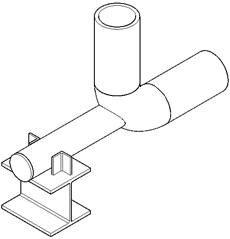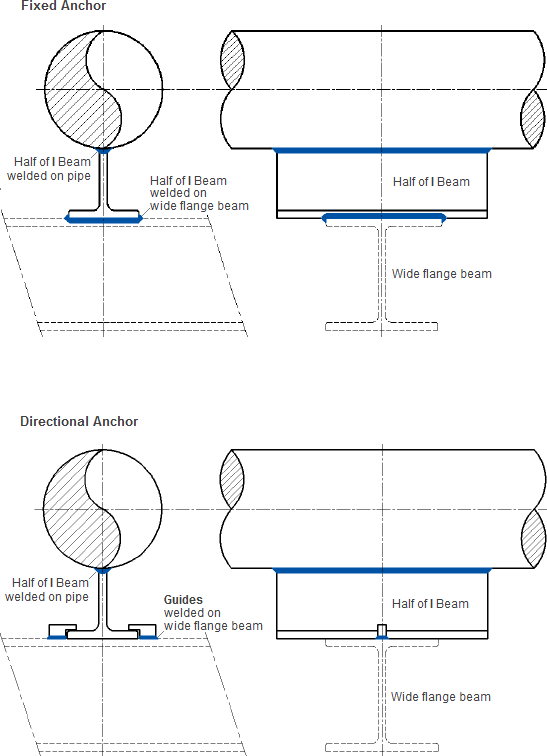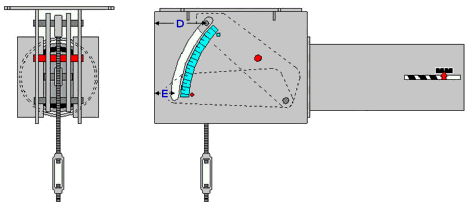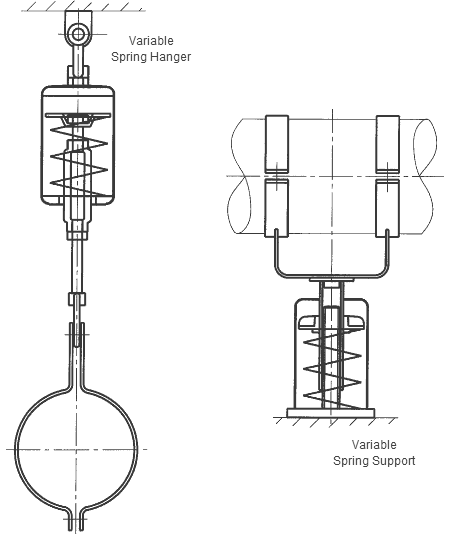Pipe Supports
Pipe is held either from above by hangers or supports of various types on which it rests. Hangers are also referred to as supports.
There are a number of typical pipe supports that can be installed to support dead weight loads, and restrain the pipe for thermal and dynamic loads.
The designs are only limited by the imagination of the engineer and designer, as literally thousands of different designs have been used for special purposes.
Pipe is rested on or secured to a support member usually of a standard structural shape (I-beam, wide flange beam, angle, channel etc.). The pipe may be secured to this member with a pipe support.
Pipe supports and hangers are devices which transfer the loads from the pipe or the structural attachment to the supporting structure or equipment. They include rod hangers, spring hangers, sway braces, turnbuckles, struts, anchors, saddles, rollers, brackets, and sliding supports. Structural attachments are elements that are welded, bolted, or clamped to the pipe, such as clips, lugs, clamps, clevises, and stops.
The correct and economical selection of the supports for any piping system usually presents difficulties of varying degrees, some relatively minor and others of a more critical nature. Proper support selection should be the objective of all phases of design and construction.
Typical Pipe Shoes

Typical Rod Hanger

Typical Dummy Leg Support

Pipe Supports standards
The code ASME B 31.3 specifies under clause 321.1.1 the ayout and design of piping and its supporting elements shall be directed toward preventing the following..
- Piping stresses in excess of those permitted in the Code
- Leakage at joints
- Excessive thrusts and moments on connected equipment (such as pumps and turbines)
- Excessive stresses in the supporting (or restraining) elements
- Resonance with imposed or fluid-induced vibrations
- Excessive interference with thermal expansion and contraction in piping which is otherwise adequately flexible
- Unintentional disengagement of piping from its supports
- Excessive piping sag in piping requiring drainage slope
- Excessive distortion or sag of piping (e.g., thermoplastics) subject to creep under conditions of repeated thermal cycling
- Excessive heat flow, exposing supporting elements to temperature extremes outside their design limits
Other support standards
- ASME 31.1 and 31.3 ie Power Piping and Process Piping
- MSS SP-58 Pipe Hangers and Supports - Materials, Design, and Manufacture
- MSS SP-69 ANSI/MSS Edition Pipe Hangers and Supports - Selection and Application
- MSS SP-77 Guidelines for Pipe Support Contractual Relationships
- MSS SP-89 Pipe Hangers and Supports -Fabrication and Installation Practices
- MSS SP-90 Guidelines on Terminology for Pipe Hangers and Supports
Determination of Support locations
Support locations are dependent on many considerations, such as pipe size, piping configuration, the location of heavy Valves and fittings, and the structure that is available for support. Following rules of thumb will help when doing the flexibility analysis and operation and maintenance..
- As much as possible, attach supports to straight pipe rather than elbows, other fittings, Valves, flanges or instruments, but provide supports near instruments, and other devices that are likely to be removed for maintenance.
- Provide space for adding loops to piping near load sensitive equipment, e.g. in pump suction lines.
- Consider the need to add friction reducing slides between the piping and support steel.
- Support piping such that spools to be removed for equipment maintenace can be removed without adding temporary supports.
- Minimize the use of spring hangers.
Determination of Loads and Movements
The anticipated movement at each support point dictates the basic type of support required. Each type of support selected must be capable of accommodating movements.
It is a good practice to select first the most simple or basic rigid support type and to add to the complexity only as conditions warrant. No advantage will be realized in upgrading a support when a simpler, more economical type can be shown to satisfy all the design requirements.
Both vertical and horizontal movement must be evaluated. When piping vertical movement is small, the use of simple rod hangers should be adequate. With small vertical movement and significant horizontal movement, the simple rod hanger will still suffice, provided the overall length is sufficient to keep the angular swing of the rod within reasonable limits-normally accepted as being 4° from the vertical.
When one is calculating the total movement experienced by the support, both horizontal displacements and the vertical displacement must be combined and normalized to the axis of the support. Consideration should be given to relocating the upper connection some percentage (usually two-thirds) of the total movement as a means for reducing the angularity in the hot position.
For piping supported from below, some form of slide must be incorporated to provide for the horizontal movement; or, in the case of ensured longitudinal movement, a pipe roll may be used. Rollers are usually only used on long runs of piping supported on racks such as found in refinery piping.
Suspended hangers with considerable horizontal movement and low headroom will require either single- or doubledirection trolleys or rollers. Where both longitudinal and lateral movements are large, consideration may be given to the use of a single-direction trolley oriented on the resultant movement vector.
Often used Pipe Supports
Anchors
A rigid support that restricts movement in all three orthogonal directions and all three rotational directions. This usually is a welded stanchion that is welded or bolted to steel or concrete.
Two types of anchors exist.. fixed and directional.
Fixed anchors are used in locations where all movement of a line must be prevented. In piping terms this is called a fixed point. The most common way to anchor a pipe is to weld the pipe directly to a support or structural member. If the pipe to be anchored is insulated, first a pipe shoe is welded to the pipe and then the shoe is welded to the steel structure.
Directional anchors are used to force movement to occur in one direction while preventing it from occuring in the opposite direction. Directional anchors are used to direct a pipe's movement away from buildings, structures, equipment etc..

Dummy Leg Supports
A dummy leg is an extension piece welded to an elbow in order to support a pipe line, and rests or anchors on some steel member.
Pipe size, length and wall thickness of the pipe-extension depends on several factors such as the total load, the parent pipe line size etc.. See typical dummy leg image on above of this page.
Hanger Rods
A vertical pipe support that incorporates a rod. It may be a rigid, variable spring or constant support hanger. Hanger is a term that often means quite different things to different people.
Rod hangers or pipe hangers attaches to the pipe by a U bolt, a clevis, a pipe clamp etc. to structural steel above.
The rod hanger provides support in the vertical direction and allows limited motion in the horizontal direction. Adjustment in the vertical direction can be accomplished by threads or a turnbuckle. See hanger rod image above of this page.
Guides
When total restriction of pipe movement is not required, pipe guides are used.
Pipe guides confine movement along the pipe's lineal axis. In piping terms this is called a sliding point. They are used primarily to maintain proper line spacing in a pipe rack and they prevent lateral or sideway movement.
Unlike the pipe anchor which is welded to the pipe and steel structure, the guide allows pipe to slide lengthwise between two angle shapes. When the pipe is supported on shoes, the angle shapes are positioned on either side of the shoe. For an image of guides see directional anchor above.
Constant Load Hanger
A specially engineered hanger that is designed to travel through many inches of vertical travel with a minimal change in support load. There are different styles and types depending on the manufacturers. Per MSS SP-58 a constant support hanger can be within specification and still have a load variation of plus minus 6% through the travel range.
Some suppliers claim a tighter tolerance on the load variation.
Constant hangers and constant supports are used for piping and related components where higher levels of vertical travel occur. Their job is to transfer the working load over the whole travel area while maintaining constancy, i.e., without any considerable deviations. The functional precision of the constant hanger is decisive for the favorable long term behaviour of the components concerned.
Constant hangers compensate for vertical movement caused by thermal expansion. Via constant hangers, the respective piping loads are constantly absorbed and transferred with no significant deviation over the whole range of movement. Significant deviations would act as harmful and uncontrolled extra loads in the system.

Horizontal constant with top attachment which is bolted directly to the bottom of the steel as shown above.
Variable Spring Hangers and Supports
A helical coil that supports dead weight load. The support load changes as the spring moves through its range at a specified spring rate. This support can be a hanger above the pipe, or a floor support below the pipe.
To prevent constraints in the system, thermal expansion in the piping and other piping components must not be hindered. The piping must therefore be supported in a correspondingly elastic manner.
To compensate for slight vertical displacements in the piping, spring components are used as supports. The functioning of these components is based on preset helical coil springs which exert a variable supporting load over the whole range of movement corresponding to the given spring characteristics.
Load variations resulting from this are limited through corresponding specifications based on stress calculations for the piping - this depends on the sensitivity of the system.

Hydraulic Shock Absorbers
The use of shock absorbers (snubbers) is preferred in thermally operating piping systems. In a dynamic event, shock absorbers instantaneously form a practically rigid restraint between the protected component and the structure. Resulting dynamic energy can at once be absorbed and harmlessly transferred.
Through the special function of the shock absorbers, thermal displacements during normal operation remain unhindered.

Hydraulic Shock Absorber (Snubber)
Summary of Pipe Supports
Pipe supports come in many configurations, and are designed to constrain pipe motion in one, two, or three space coordinates. Only the most common types are described on this page. Manufactures have catalogs that thoroughly illustrate supports of all types.